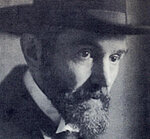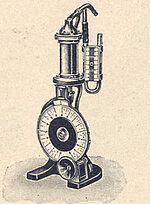Tone-Variator according to W. Stern
Stern’s tone variator
In 1902, William Stern once wrote: “The tone variator is a device that was invented for very specific reasons and that can - now that it has been perfected - be used for acoustic demonstration purposes and general experiments of any kind.”
According to Stern, Carl Stumpf was the one having originally proposed the invention that, eventually, was based on an idea of Hermann von Helmholtz who discovered that blown-at bottles can produce almost harmonic-free sounds, which can be tuned by filling the bottle with liquid wax or oil.
In collaboration with Oehmke and Tiessen, two mechanics from Berlin and Breslau, William Stern improved the basic principle until it was ready for series production.
The modification within the pitch of Stern’s tone variators is not caused by the pouring of oil or wax, but by a specific mechanical system
Instead of using a glass bottle, Stern decided work with brass-cylinders in order to adjust the different pitches. On the one side, the pitches were closed by a lid that could be blown at, and on the other side a piston could be inserted if the air volume had to be modified. Correlating with the different pitches, the up- and downward movement of the piston was regulated by the cogs within the cylinder. However, the realization of the up- and downward tendency is of special interest, since it was not performed linerally, but logarithmically, in order to reach a steady change within the pitch. Eventually, Stern managed to turn Fechner’s law – that all sensations are logarithmic functions of physical intensity - into a mechanical device.
3D-animation of Stern's Tonvariator No. 4
Literature:
Helmholtz. H.v. (1862). Die Lehre von den Tonempfindungen. Braunschweig: Vieweg & Sohn.
Stern, L.W. (1902). Der Tonvariator. Zeitschrift für Psychologie und Physiologie der Sinnesorgane. 30. 422-432.
Stock, A. (2011). About the historical development and precision of psychoacoustic instruments. Part 1: William Stern’s Tone-Variator. Teorie & Modelli. Rivista di Storia e Metodologia della Psicologia, XVI, II, 103-115.






